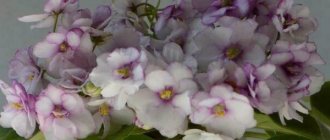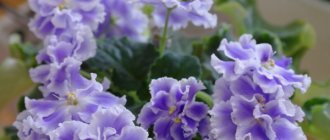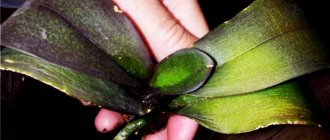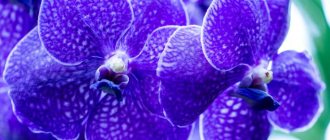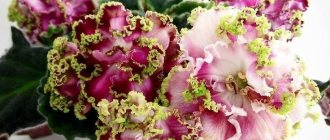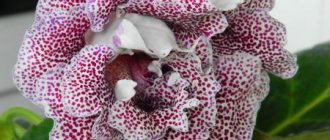A little about watering
Violets should be watered as the soil dries.
Accordingly, this will have to be done more often in the summer, and less often in the winter. In addition, the soil dries out faster in small pots than in large ones. Watering should be done only with settled water - not cold from the tap. It is advisable to pour water into a suitable container - a glass, jar or any other with a wide neck (to facilitate the process of chlorine evaporation) and leave for a day. During this time, it will warm up to room temperature and get rid of dangerous chlorine. Too hot or cold water may well lead to diseases and damage to the roots.
When watering, try to pour water directly onto the ground. If it gets on the leaves on a hot sunny day, burns are possible - white spots will appear on their surface.
Possible diseases and pests, ways to get rid of them
Violet Blue Mist can suffer from certain diseases and parasites:
- Spider mite. This insect attacks many indoor plants, including violets. The danger of spider mites is that they multiply and spread very quickly.
Its presence can be determined by the appearance of a sticky coating on the leaves. Some people wash plants with soap to combat it, but it is best to purchase a specialized product (for example, Fitoverm or Actellik) against this type of parasite.
Fitoverm helps get rid of spider mites
- Whitefly. As a rule, it appears on plants if the room humidity and temperature are too low. To control insects, you need to use a general insecticide.
- Mealybug. It is dangerous because it sucks the juices out of the plant, which is why it gradually withers, stops growing and may even die. To get rid of it, the most effective remedy is a soap solution.
- Powdery mildew. The development of the disease can be determined by the appearance of a white coating on the leaves of the plant. You can get rid of powdery mildew by treating it with a fungicide.
- Fusarium. When this disease develops, the violet can die very quickly. It is very difficult to identify fusarium in a timely manner, since the root system of plants is primarily affected.
As a rule, when the disease spreads to the foliage, it is too late to do anything. If the lesion has not yet reached the leaves, then you can cut off the entire healthy above-ground part of the flower and try to grow it again.
Features of care
Blue dragon.
blue dragon Violets prefer light, which plays a huge role during flowering. It is also not recommended to keep the plant in direct sunlight.
Particular attention should be paid to watering the plant, since due to severe waterlogging of the soil, the roots begin to rot, as a result of which the violet dies. All violets need high humidity, but spraying is not recommended for this, as this procedure leads to the formation of spots on the leaves
Violets are heat-loving indoor crops; they are best grown at air temperatures from 16 to 21 degrees above zero. Fertilizers are applied no more than once every 4 weeks.
Features of care
Indoor violet “macho”: description and cultivation
Violets prefer light, which plays a huge role during flowering. It is also not recommended to keep the plant in direct sunlight.
Particular attention should be paid to watering the plant, since due to severe waterlogging of the soil, the roots begin to rot, as a result of which the violet dies. All violets need high humidity, but spraying is not recommended for this, as this procedure leads to the formation of spots on the leaves
Violets are heat-loving indoor crops; they are best grown at air temperatures from 16 to 21 degrees above zero. Fertilizers are applied no more than once every 4 weeks.
Photo and description of the violet variety “Green Lagoon”
Violet “bohemia”: description and cultivation features
This plant, as mentioned earlier, has an unusual color. The outer petals of the green lagoon violet have a greenish tint, their main color is white. The petals have streaks of a bluish tint. The shape of the green lagoon violet flower is also very unusual; in appearance it is somewhat similar to cabbage forks. However, gardeners often complain that the flowers begin to darken with subsequent blooms. If the plant is not renewed, it will eventually form a dark purple variety.
You should also pay attention to the fact that the “green lagoon” violet, the photo of which is presented in this article, blooms infrequently. However, this disadvantage is compensated by prolonged flowering.
When looking at the photo and description of the “green lagoon” violet, it is imperative to mention that the plant produces from 4 to 5 peduncles, on which large flowers are formed. The first ones are the largest, and the subsequent ones can be smaller.
What else can be said about the description of the violet variety “green lagoon”? This plant blooms for the first time approximately 2 years after planting. In hot weather, violets have less of a green tint and more of a bluish tint. In cooler weather, the petals take on a greenish color.
The leaves of this variety often rise upward; this is a varietal feature of the “green lagoon” violet, the care of which will also be described below. The buds of the plant are quite heavy, and the flower stalks are weak, so the raised leaves seem to support the flowers, so the bouquet does not fall apart.
This variety is often subject to various diseases, in particular, rotting of the rosette itself. Many people complain that the flowers begin to dry out inside before they have time to bloom. To prevent all this from happening, you need to familiarize yourself with the peculiarities of growing “green lagoon” violets at home. We'll talk about this in the next section.
The rich world of blue Saintpaulias
Not everyone knows that Uzambara violets were originally blue in color. It was cornflower blue, indigo, and sapphire indoor beauties that conquered the world. Even in ancient times, blue symbolism was highly valued. This color was associated with modesty and purity of thought.
You may be interested in: Syngonium flower: description, photo, home care
In the article we will look at the most beautiful blue violets, their characteristics and external features. We invite you to look at a photo gallery of these indoor plants of extraordinary beauty. Below you will read in more detail a description of the 9 main blue varieties. In addition to them, it is also worth highlighting the following cornflower blue violets: Arabian Night, Aphrodite, African Night, Running on the Waves, Viscount, Misty Cloud. The Heavenly Queen violet is also very impressive. Many varieties will be described in the article.
You may be interested in: Hosta: how to propagate and grow the plant
TOP 10 most popular varieties
Pink Panther
A luxurious bouquet of delicate, pink-cream flowers. The edges of the petals are corrugated, with a wide white border, in the middle the color is brighter. In the center of the flower the shade is more saturated. The flower is very double and printed. The petals are arranged from the center of the bud in a graceful spiral.
The rosette is compact, smooth, rich green in color.
EK-Goddess of Beauty
A spectacular, very rich variety of fuchsia-colored violet with a slight lilac tint. The petals are wavy, very elegant, festive.
Large flowers can reach 7 cm in diameter. They are very heavy and droop a little and can be laid on the leaves. Many buds open at once - up to ten.
Your Majesty
The even pale raspberry color of a cold, pure shade gives Your Majesty the violet royal sophistication and brilliance. Lush buds look like a ballerina’s tutu, the petals are smooth and very laconic in shape, without unnecessary curls, with a diameter of 5 cm.
The rosette is large, formed neat and even.
Aelita
Lush corrugated inflorescences with delicate watercolor tints on the petals - at the edges the color dissolves in a milky shade, and closer to the middle it approaches crimson or peach.
The Aelita variety is prone to cap flowering. Compact bush with embossed leaves.
LE-Peachy shine
Warm, caramel peach bouquet. The flowers are very large, 6-7 cm. Just one row of lacy petals is decorated with crimson rays radiating from the center of the inflorescence. The bright yellow stamens are well defined and pleasantly highlight the richness of the bud.
Standard size rosette, leaves with long petioles.
Winter smiles
The incredible variety Winter Smiles is unlike others - as if the snow is sparkling in the sun, and there is a lemon or lettuce openwork edge around the edges. The flowers are medium in size - about 5 cm.
Blooms long and profusely. The underside of the leaf is purple.
Fairy (Dadoyan T.L.)
Pale pink violet with star-shaped flowers and small purple markings - dots and stripes. Lace fringed edges, round buds, similar to cotton candy balls.
A fabulous lush bouquet of a dozen flowers is common for this variety. Standard dense rosette of large leaves.
Buckeye Colossal
This violet looks more like an outlandish orchid than a cute bush from grandma's windowsill. Lilac star-shaped flower, semi-double. Scarlet or purple sparkles are scattered along the edges of the wavy leaves. The buds are medium in size, about 5 cm.
SM-Pink pearl
Pearlescent double inflorescences with slight tints on the petals from peach to cool pink. In the center of the petal the shades become brighter. Diameter up to 6 cm.
The socket is standard, smooth, and does not require shaping. The flowers remain fresh for a very long time.
RS-Pink Paradise
A lush cap of delicate, very decorative crimson flowers with fuchsia splashes around the edges. The core of the bud is almost white.
Pointed lettuce leaves emphasize the freshness of the elegant bouquet. The flowers are simple or slightly double, the edges are slightly wavy, but very beautifully molded.
Blue variety Summer Twilight
This wonderful blue Saintpaulia became a delightful masterpiece of the breeder Konstantin Morev. Violet Summer Twilight is on the lips of many today. She was loved by flower growers for her extraordinary brightness. Sometimes it is also called Morev's violet. It is memorable for its variegated leaves and petals. This Saintpaulia forms a neat, flat, medium-sized rosette. Slightly concave quilted green leaves have a blurry white border at the edges. It is the contrast of blue and white that makes this beauty recognizable.
This variety cannot be confused with any other. It is distinguished by large double and semi-double stars up to 6 cm in diameter. Each petal in the center has a blue-violet color and a white edge. We must pay tribute to the velvety petals with a wavy edge. Bright, lush, voluminous flowers attract attention. There may be so many buds on the flower stalks that they sag under their weight.
Saintpaulia Summer Twilight blooms long and abundantly. Even young rosettes tend to bloom. Caring for this variety is not very difficult. Even beginners can wait for it to bloom. A flower pot can be placed either on a windowsill or on a shelf. The plant should be protected from too bright sun so that the white spots on the leaves do not get burned. This violet loves cool weather. In hot weather, the variegated leaves become duller. Excessive lighting leads to drooping leaves.
Features of life processes
The life cycle phases of varietal Saintpaulia generally proceed according to the standard growth laws for Uzambara violets with minor deviations from the norm. Compliance with all the nuances guarantees the preservation of the health and decorative appearance of the plant.
Development of Saintpaulia in home culture
Violet belongs to a fairly problem-free species of the genus. Its only drawback in terms of decorativeness is the formation of a leaf rosette with a loose structure, but provided there is lush flowering, the insignificance of the leaf mass does not spoil the appearance of Saintpaulia too much.
At the time of development of the leaf rosette, young leaves may exhibit an elongated petiole structure. This defect is eliminated by itself as the specimen grows, without disturbing the overall decorative effect - you just need to wait a little.
The variety blooms for a long time with short rest intervals. Each subsequent formation of buds can begin as early as a month after the previous corollas have fully flourished.
ATTENTION! The large volume of developing buds and their heaviness (due to their significant size) provoke some disintegration of peduncles along the leaves of the rosette when all corollas are fully opened. To enhance the strength of peduncles, the necessary fertilizing should be applied in time. Saintpaulia is distinguished by the good formation of children using the leaf cuttings method and the rapid growth of new rooted bushes
Saintpaulia is distinguished by the good formation of children using the leaf cuttings method and the rapid growth of new rooted bushes.
Time for bush formation to adult phase
Propagation of violets by leaf cuttings guarantees early flowering of young bushes, since the variety is characterized by the rapid formation of a leaf rosette in young children.
This means that a rooted shoot can become an adult plant in just 8 months.
If you used the method of obtaining a young specimen by rooting a child from the mother violet, then maturation will occur even earlier, since there is no need to spend time on the formation of the child itself - the shoot has already been grown by the plant.
Features of reproduction methods
To obtain young specimens of varietal Saintpaulias, flower growers have to use only two of the possible propagation methods:
- Rooting a shoot grown on an adult bush with its preliminary separation from the mother plant;
- Formation of several children on a specially prepared leaf cutting, which the variety produces very readily, and their subsequent rooting in their own flowerpots.
CAREFULLY! The method of seed propagation should not be used, since almost all varieties of violets are hybrid varieties that, according to biological laws, are not capable of transmitting varietal characteristics to offspring during sexual reproduction.
To guarantee the reproduction of the characteristics of the variety, it is possible to use rejuvenation of Saintpaulia.
The nuances of flowering at different temperatures
The formation of buds under optimal temperature conditions provides the variety with flowering with the formation of a mass of peduncles guaranteed according to the author's description, which leads to the blooming of huge corollas in the form of a lush cap above a small leaf rosette.
Elevated temperatures at the time of bud formation can shift this important life process of the violet to a more favorable time frame or completely cancel the next flowering phase. If the flowers do begin to bloom, the following may happen:
- Deformation of buds;
- Grinding whisks;
- And a decrease in the decorative value of violets.
Special features of peduncles
A characteristic feature of the variety is the almost simultaneous formation of a large number of peduncles, each of which bears up to two large buds. The peduncles are formed strong, but when all the corollas are completely dissolved, their strength is not always enough to support the flowers in an upright position - a slight disintegration to the sides is possible.
Important! The flower stalks are a little high at the first flowering, but then everything returns to normal.
Type of varietal flowering
During flowering, a violet is capable of simultaneously forming a large number of peduncles, which leads to the formation of a voluminous flower cap, which, as new buds bloom, takes on a spherical shape of a dense structure.
Lifespan of one bud
This violet blooms profusely and for a long time.
Saintpaulia can bloom every time for up to three months, while maintaining the chic decorative appearance of the flower cap, and each individual corolla can not lose its freshness for about a month.
Tips for caring for blue Saintpaulias for better flowering
Some violets bloom once a year, others produce only a few peduncles, and others are distinguished by beautiful blue caps two to three times a year for two months. For frequent and abundant flowering, carry out the following activities:
- Watch the lighting. The flower loves intense light. The best place for it is on the windowsill, 30 centimeters from the window.
- Use artificial lighting on short days.
- After two weeks, feed with violet fertilizer.
- Water regularly with soft water at room temperature.
- Use nitrogen-rich soil for planting.
If you listen to our advice, then all of the above varieties of blue and cyan violets will delight you with abundant flowering.
How to care
Before you buy your first viola to grow indoors, you should familiarize yourself with the basic tips for caring for it:
- Sowing is carried out in a special substrate adapted to the needs of the crop.
- Containers with drainage holes at the bottom are used.
- It is better to use plastic containers for planting; clay roots can overcool them.
- The pot is placed on window sills with moderate lighting: western or eastern.
- Provide good lighting - at least 10 hours.
- During watering, the outlet is protected from moisture, otherwise the development of fungus or mold is possible.
- Water for irrigation should be warm.
- In order for the plant to bloom satisfactorily, it must be fed periodically.
https://i.pinimg.com/736x/13/4e/32/134e32b54c93649a4bf62d92f30e81f1—grace-omalle
Blue violets are very popular among gardeners. They are valued for their lush and long flowering, the ability to form lush bud caps, and their relative unpretentiousness. For cultivation, a novice gardener should choose not the most capricious varieties, and then the process will end successfully.
History of the appearance and selection of violets
The discoverer of the violet is Governor von Saint-Paul, who accidentally discovered the violet flower while walking with his bride.
He sent it to his father, an avid gardener and collector of different types of orchids - Ulrich. Which, in turn, sent the flower to Hannover, the director of the botanical garden, for identification. Herman Wendland attributed the violet to the Gesneriev family.
Officially, the year of birth of the flower is 1893. At this time, the plant visited various exhibitions and was described for the first time in magazines.
The history of selection begins in 1898. Saintpaulias with red-violet flowers were obtained. In 1920, violet cultivation began on an industrial scale and therefore selection gained momentum. Flowers with spots on the petals and the first double varieties were obtained.
By 1946, the violet family already included over 20 varieties of various colors - from pink to blue, including pure white ones. Saintpaulia appeared in the neighboring countries in 1960 and almost immediately became everyone’s favorite.
Tips for choosing a variety
Before growing any subspecies of this plant, you should first find out about the susceptibility to diseases of this variety, as well as the level of resistance to low air temperatures. Each individual subspecies is endowed with its own special characteristics and qualities. Some of the subspecies have a rather capricious disposition, which is why it is quite difficult for beginner amateurs to cope with them. Thanks to the work of breeders, approximately two thousand hybrid varieties have now been bred in nature. Among the subspecies with a blue tint of flowers, you can find specimens with buds of a classic, star-shaped, limbic shape. It is worth noting that all these plants can be divided into boys and girls, and their gender can be determined by their leaves. If there is a spot of a rich shade at the base of the plant’s foliage, then this is a girl. Depending on the preference of the gardener, you can make your choice in favor of a crop with a miniature size near the outlet, or a large one. Before purchasing this plant, you should first inspect the flower for the absence of spots on the foliage or gaps between them. All these factors may indicate that the flower is infected. When stretching the bush to a height, we can conclude that it was kept where it did not have enough sunlight, so it becomes suspicious whether its root system under the soil is healthy. Look carefully: on each container with a flower there should be information about the name of the plant and its variety; if possible, compare the plant with a picture on the Internet.
Saintpaulia Blue Chiffon
Blue Dragon is a legendary variety bred by Sorano. Present in almost all collections. Violet growers love it for its large, beautifully shaped light blue flowers with a wide reddish-purple ruffled border and a white-green edge. This variety is never forgotten! It is somewhat capricious in cultivation, does not forgive errors in agricultural technology, and loves natural light and fertilizing.
Faded Denim (Sorano). Violet light light blue denim. Huge semi-double and double pastel blue (the color is applied in several layers) hollowed out and wavy stars are beautiful. There won’t be any special maintenance problems if the Faded Denim lighting is bright enough. In dim light, the flower stalks stretch out and fall under the weight of huge flowers.
Ma's Toxic Spill(Robinson). Spilled poison. The moire color of the petals is really similar to the multi-colored stains that occur from gasoline on puddles after rain. Semi-double blue stars with polka dots and touches of white, pink and dark fantasy blue. It blooms readily, long and abundantly.
Opera's Romeo(Burdick). Romeo. Large semi-double bright blue stars. White edge and polka dots on the petals. Abundant flowering. It looks much more beautiful in life than in the photo.
Optimara Annabelle (Holtkamp). Annabelle from the Optimar series. If you love field bells, then this variety is for you! This is a huge bouquet of bright blue bells. Small dark foliage, compact rosette. The peculiarity of this bell-shaped variety is its slightly elongated stem. The variety is very original.
RhapsodieClementine (Holtkamp). The RhapsodieHoltkamp series is distinguished primarily by its abundant bouquet flowering. Simple light blue wavy Clementine stars are gathered in a dense cap and look like a bouquet of spring snowdrops. Dark green foliage forms an even show rosette. The variety is very photogenic and often takes prizes at photo exhibitions.
Vince's Choice (Eyerdom). Vince's Choice blooms with large double bright blue stars with a crisp white edge. The violet is neat, medium-sized rosette, strong peduncles. Easy to care for. The mother rosette is the winner of the Competition “Best violet selection by Freddete and Eyerdom” at the Flower Vernissage 2010. (1 place).
Domestic varieties are also richly represented in blue tones.
Violet Blue Dragon
Saintpaulia Blue Dragon has a very beautiful name, isn’t it? And the flower is even more beautiful! It is distinguished by semi-double and double stars of light blue color. In the center of the blooming rosette the flowers are dark blue, which makes them stand out very effectively. The petals have a purple or light green border. Pictured above are Blue Dragon blue violets.
It can be seen that the flower is decorated with dark green foliage with slightly jagged edges. The leaves are slightly reddish on the underside. Blue Dragon is a fairly large variety with a powerful rosette of buds and succulent leaves. The rosettes are vase-shaped. The petioles first stretch upward and then unfold into leaf blades horizontally. The emerging leaves are slightly curled, but then straighten out.
A blooming rosette of flowers resembles a terry hat. Each petal has a reddish-purple ruffled border, resembling a ruffle. Maybe the variety is called Blue Dragon because an ominous purple border appears on the light background of the flowers. This violet blooms profusely and willingly, like a bouquet. The diameter of the flower can be 7 cm. The peduncles are very persistent and elastic. There are up to 8 buds on one stem. Particularly bright flowering is observed in winter. In summer, the petioles begin to grow and the leaves rise up. The Blue Dragon owes its abundant flowering to its powerful root and leaf apparatus.
You may be interested in: Pilea monetifolia: description with photos, reproduction, care and properties
Indoor violet: names and descriptions of famous varieties
Saintpaulia can be classified in a variety of ways: by the size of the rosette, leaves and flowers, shape, color, type of surface and border of the leaves.
Each variety stands out from the others with its characteristic individual features.
The following options are available:
- Semi-double. The petals are covered with very small shiny balls. Often there are species whose leaves are covered with soft fluff. This variety is also called velvet. The edges of the petals are wavy or slightly corrugated.
- Terry. Forms lush racemose inflorescences. They are usually large - 2-9 centimeters in diameter. The color comes in a wide variety of shades.
- Violet Star. Has a standard petal size. They are always evenly spaced around the core.
- Pansies. Saintpaulia of this variety has a bud consisting of five petals. The three lower petals are much larger in size than the two upper ones.
- Bell. The variety is distinguished by petals fused at the base. The shape of this plant is very similar to a bell - because it does not open completely.
- Wasp. A distinctive feature of the species is that the five petals of the flower are completely separated. Two of them are rolled into a tube, and three are extended and hang down.
- Chimera. This variety combines several varieties. The general background of the flower is painted in a basic tone, and the top layer looks like a spot or a clear stripe.
- Mini. It may also be called a miniature type of violet. The size of the inflorescences does not exceed 2-2.5 centimeters. Their colors come in a wide variety of colors.
- Retro. Saintpaulia is a fast-growing and does not require any special care. It has dense and spreading inflorescences. The petals have an unusual vein-like pattern. The veins on the stems are clearly visible.
- Variegated. This species is distinguished by the fact that the petals have lighter shades on the main color in the form of a uniform edging of the leaves.
- Ampelnaya. This variety is suitable for growing on balconies in hanging flowerpots and pots. Of this species, Saintpaulias look beautiful, their color is blue with a white border, while they have a green center. This plant variety has several growing points. A lot of young shoots are formed on the sides. The stems are long, drooping, directed straight down.
- White. This species has large, dense, double flowers. The socket is small.
- Pink. Blooms profusely and for a long time. The petals are painted pale pink. They are wavy and have a light green edging along the edges. Small lilac specks are visible on the edges of the petals.
- Purple. It has single or semi-double purple flowers. The edging is wide, pinkish, strongly wavy.
This is interesting: the Latin name of this plant is Viola. Old lovers of indoor flowers often use just this name - Viola.
Violet Winter smiles
The elegant variety of violet Winter Smiles belongs to the most famous and oldest breeder of Russia B. Makuni. Compact plants generously reward the lover of this culture with semi-double or double flowers with a diameter of up to 5.5 cm. The color of the petals is complex and harmonious. A light pink background, on which crimson tint strokes stand out. The fringed edge, reminiscent of frost sparkling at dawn, has a delicate yellow-green tone. When keeping plants in a hot room, the border becomes lighter to white. The flat rosette of Uzambara violet, as in the photo, consists of green rounded leaves, sometimes with an olive tint. The edges of the foliage are jagged, the leaf blade is embossed and quilted.
The most popular varieties of the AB series and their photos
Home orange flower name
Every collector has types that are the most popular. And the violet grower is no exception.
Polar bear
The flowers of this species are large and voluminous. They resemble balls in shape. The color of the petals is white, and the flowers themselves are densely double. The leaves are medium green, slightly wavy and quilted at the edges. Plant sizes are standard. It was withdrawn in 2022.
Bohemia
This indoor flower became available to Russian flower growers in 2015. The color of the flowers is similar to that of fragrant ripe cherries - it is burgundy-black. Dark green foxtails have sharp tips. This sorso blooms on all sides, the flowers form a dense ball resembling a hat.
We recommend watching a video about the violet variety “Bohemia”:
Kishmish
This variety of violet will allow you to grow large flowers, shaped like stars. The petals are dark crimson, their edges are white, corrugated. The rosette is compact and has medium green, toothed leaves that are slightly wavy. The variety was bred in 2015.
Coral Castle
The variety exhibits semi-double and double flowers. They look like pansies with a ruffled brown edge. Their color is coral-raspberry. The leaves are green, wavy and oval in shape. The bush sizes are standard.
Crimean Cherry
Pansies are distinguished by their corrugated petals. The flowers are double type and have a dark burgundy color. Leaves are dark green. They have an oval shape and a pointed tip. The leaves are slightly wavy. Standard sizes.
We recommend watching a video about the violet variety “Crimean Cherry”:
Terry Petunia
The flowers of this plant resemble roses with white petals, and along the edges there is a corrugated edging of dark cherry color. This is a small standard with a compact socket. It has medium green wavy leaves. The variety was released in 2022.
Mexican Jerboa
The branches are large, their color is ash-pink. They are shaped like stars. There is a dark crimson edging. The edges are wavy. The leaves are dark green, wavy. Compact size socket. The variety was released in 2022.
We recommend watching a video about the violet variety “Mexican Jerboa”:
Mimosa
Mimosa is a semi-double flower whose shape resembles stars. The flowers are semi-double, have a wide corrugated green edge and a crimson edging. The leaves are quilted, medium green. The variety is standard, was obtained in 2022.
Natasha Rostova
Flowers are double type, large in size. They have wavy edges. The shape of the flower resembles stars. The color of the petals is white, and they are framed by a crimson edging. The leaves are medium green and serrated. This variety was released in 2022
Plush
The stars are large, semi-double. Their color is purple-violet, and the edging is dark purple. The texture of the foliage is such that it visually and to the touch resembles plush. They are dark green in color, pointed at the edges and quilted. The variety is standard, released in 2022.
The Snow Queen
White stars of large size and semi-double type. They are distinguished by a corrugated purple edge and a fancy blue eye. The leaves are medium green, jagged and slightly wavy. The plant was bred in 2022.
Furor
It is distinguished by huge and semi-double stars. Their color is white and their edges are wavy. Fcussion prints are scattered across the petals. The leaves are quilted, toothed, and medium green in color.
Tango
The plant forms large double-type stars. The color of the petals is dark cherry. The rosette is medium green, flat. The leaves are green, wide, and have a slight velvety feel on the outer surface.
Gypsy Wedding
These are semi-double pansies, which are distinguished by a bright red spot located in the center of the flower. the edging is corrugated and green. The foliage is also wavy and dark green in color.
To ensure long-term flowering, it is important to regularly use complex mineral fertilizers
Mysterious forest
It is distinguished by huge and semi-double stars. Their color is white and their edges are wavy. Fcussion prints are scattered across the petals. The leaves are quilted, toothed, and medium green in color.
Bomb
This variety was released in 2022. Its flowers are huge and pink. They can be single or semi-double. They are shaped like bells. The edges of the petals are white. The rosette contains black and green quilted leaves. Plant sizes are standard.
Absolem
The variety was released in 2022. It is distinguished by large double white stars. They have wavy edges that are purple in color. The braid is wide and green. Present on the upper petals. Quilted medium green leaves form on the rosette.
We recommend watching a video about the Absolem violet variety:
Gift for Loved One
This hybrid has large double fringed blue flowers, along the edge of which there is a red-purple border. Violet Gift for Beloved is an exhibition plant with a perfect rosette that forms independently.
The flowers have a dark blue color and a fairly clear border. There are many buds on the peduncles, forming real caps. Large and bright flowers last a long time, up to a month and a half. The variety has positive parameters and is unpretentious to lighting.
You may be interested in:How to grow succulents from seeds: choosing seeds, planting rules, germination and care
Pay attention to the leaves of this indoor plant. They are also very decorative. They are dark green in color with a creamy pink border. Even without flowers, the rosettes look elegant.
Even a photo cannot convey all the beauty of the Gift for Beloved variety. You can really give it as a present to your man. A neat rosette looks very harmonious.
Growing violets at home from scratch: where to start?
There are several ways to propagate Saintpaulias:
- seeds;
- stepchildren;
- leaf.
Whatever method you choose, first of all, you need to select high-quality planting material:
if these are seeds, then they should be treated before planting for better germination. You should buy seeds from trusted breeders. Otherwise, you risk buying low-quality material;
Violet seeds.
if you decide to breed violets with stepsons. Then they should be separated from the mother plant when the roots reach 1-2 cm
They can be rooted in water or directly in the ground; When purchasing a leaf for propagation, pay attention to the plant from which it was taken. It must be healthy, without external damage
ADVICE! Try to take planting material from a flowering plant, this way you have a better chance of getting a high-quality plant.
The baby must be kept in a greenhouse, ventilated periodically.
When 1-2 leaves appear, it is accustomed to normal conditions, opening the greenhouse slightly for a while for 2 weeks. Each time it should increase.
When the greenhouse is completely cleaned, the baby can be transplanted into a pot and certain conditions can be created.
Choosing a place
Be sure to take into account several important points on how to position the violet correctly:
- light;
- temperature;
- humidity.
Indoor violets are best placed on northern, northeastern and northwestern windows. When placing pots on other windows, Saintpaulia will grow well, but it must be protected from the sun.
The violet should be protected from direct sunlight.
IMPORTANT! Violets love a lot of bright light, but do not allow direct rays to hit the plant. When deciding which window is best to grow violets on, remember that at noon it must be shaded in any case
This can be non-woven material, tulle folded twice, blinds help well
When deciding which window is best to grow violets on, remember that at noon it must be shaded in any case. This can be non-woven material, tulle folded twice, blinds help well.
If you decide to block the glass on the windows from the sun, then you need to do this so that the rays do not hit the plant, about two-thirds of the window.
There is no need to cover the plant in the evening; the sun's rays at this time are not dangerous.
Decide where in the apartment it is warmer and where it is cooler. Which windows always receive sunlight, and where it rarely happens. Where do drafts occur during ventilation?
Different varieties of violets require different placement conditions. It can be placed both on very light windows and in the shade. To prolong flowering, use artificial lighting.
Lighting
In order for your violet to grow healthy and strong, it needs to be provided with enough light. It should be diffused, without direct sunlight.
It is possible to create artificial lighting. In this case, the optimal distance from the lamp to the plant is 15-25 cm.
The ideal lighting would be alternating lamp and daylight lighting.
Temperature
For small, immature plants, a comfortable temperature will be 24-26°C. Violets can safely tolerate short-term temperature changes, but sudden changes are detrimental to them. The night temperature should not be more than 6°C lower than the day temperature.
INTERESTING! For violets to bloom, the temperature should be slightly below normal.
Saintpaulias do not tolerate constantly elevated temperatures.

